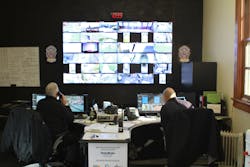Every day, new incidents occur that remind us that enterprise and critical infrastructure systems across the nation continually face threats to their security. These threats can take on many forms: terrorists, disgruntled ex-employees, inadvertent employee errors, cyber-attacks. Companies need to take a proactive stance, developing comprehensive security strategies to protect their resources. Sophisticated display technologies, such as video walls, when deployed as part of a larger security strategy, can help enhance operator awareness and enable enterprises to better defend the security of their infrastructure.
Protecting Infrastructure with Effective Display Technologies
The term “infrastructure” can encompass a variety of facilities: warehouses and manufacturing plants, oil and gas refineries and pipelines, water distribution and treatment plants, transportation systems, shipping facilities and airports, and even large sports venues. A single facility may incorporate many different sub-systems such as HVAC, access points, elevators, water systems, lighting, fire alarms, announcement and intercom systems, burglar alarms, phone networks, location tracking, and video surveillance equipment. These systems are separate, but also interconnected, and operators need the right tools to help them monitor these systems in real-time, and access them immediately when potential issues are detected.
Deployed as part of the overall strategy, video walls, or integrated arrays of wall-mounted monitors, enhance the effectiveness of surveillance and security systems. Video wall processors consolidate the display of outputs from multiple types of systems. Security camera video feeds, alarm systems, fire systems, product diagrams, remote system management information, highly-specialized information, such as SCADA system monitoring for large facilities – information from pretty much any system that has any kind of video output can be configured for display by the right video wall processor.
The Advent of Megapixel Surveillance
Security teams should be aware of the benefits provided by advancements in video wall processing technologies when selecting their system components.
A new trend in video wall processing technology is the ability to configure and display 4K/UHD (ultra-high definition) video inputs. With ~8.3 million pixels, 4K/UHD offer significantly higher pixel density than conventional high-definition (HD) signals, as much as 4x more total resolution. 4K/UHD video and imagery provide stunning clarity and dramatically more detail when displayed on a video wall.
Most major camera manufacturers now offer such 4K/UHD megapixel cameras that record video at 3840x2160 resolution, 30 frames per second (fps). When compared to HD or lesser resolution cameras, megapixel cameras offer a wider field of view for tracking emerging situations in real time, while also providing enough pixels to enable users to zoom in on and analyze the details of these ultra-high quality images. For example, in a sports arena, a security team monitoring 4K camera feeds on a video wall might notice the beginning of an altercation, quickly zoom into the appropriate area of the arena to be able capture facial images of the individuals involved and forward those images to security personnel in the stands.
While ultra high resolution imagery enhances surveillance and provides multiple benefits for security personnel, the increase in resolution can also pose challenges to the video wall processors and systems behind the monitors. For example, because of bandwidth demands, even a high-performance processor might only be able to decode two or three IP-based 4K video streams at any one time. If a security team needs to monitor 10, 20 or even hundreds of streams to provide comprehensive situational monitoring, it is better to allow dedicated PC servers to handle IP decoding. However, to enable consolidated display of information from all of these systems, you need to choose a video wall processor that is capable of communicating with, and processing information from, a variety of servers and systems.
Consolidate Control to Enhance Response
Wall processors vary greatly in their capabilities; when used for security monitoring purposes, you should look for a video wall processor that provides operators with consolidated control over information from multiple disparate systems, such as access control, video surveillance, and fire alarm systems. These are typically separate systems that were not originally designed to work together. However, by consolidating the display of the video outputs of these systems, video wall processors allow teams to look at and respond to all of this information at the same time, and be able to customize the layout of imagery, so that relevant information can be displayed together to enhance monitoring.
For example, a hospital might have a system in place to prevent the kidnapping of newborns. Babies wear bracelets embedded with an RFID chip, which would immediately sound an alarm if a baby is taken from the maternity ward. This alarm should trigger a series of related security protocol events: when the alarm goes off, doors around the unit need to automatically close and lock, and cameras installed around the ward should reorient to automatically record doorways and other access points to capture images of the suspected kidnapper. An operator should be able to recall a preset to immediately change the appearance of the video wall, to ensure that all imagery relevant to the critical situation is displayed. The ability to simultaneously view and analyze hospital maps, imagery related to the location of the baby, video feeds from each doorway, photos of both baby and suspect, status of all access points, etc. can help operators better respond to situations when timely action can make all the difference in the outcome of the scenario.
As another example to illustrate the benefit of combining the display of multiple, disparate systems, managers at a wastewater treatment facility might display maps of building wiring and plumbing, and overlay windows of visual data, such as video feeds from various cameras. If an alarm sounds to indicate that pressure is dropping at a valve, cameras can automatically reorient to record footage of the valve in question and alert personnel to a potential issue. An operator can then analyze the video streams to determine if a false alarm has occurred or if there is an actual incident that requires further attention.
Collaborative Tools
For collaborative applications, it is also important that operators be able to highlight specific information displayed on a video wall, so that relevant information can be viewed and analyzed by a larger group. A large video wall may have hundreds of images displayed at one time, so individual operators need to have tools that let them alert team members to look at a particular window on the wall: e.g. the ability to add borders around windows, change the color of a border to instantly highlight imagery, edit on-screen text or add annotations to graphics or video.
Factors to Consider Before Choosing a Video Wall System
When considering the possible components of a new video wall system, security teams should think of it as more than just a wall of monitors. A high quality video wall is a continuous, multi-screen surface on which to display graphics and video, seamlessly and with synchronization, in fully-scalable windows. For the most functionality, users should be able to customize the display, positioning video and images anywhere on the wall, including across monitor bezels. As with any technology, designing the right video wall processor into a security system involves prioritizing between multiple requirements: visual clarity, responsiveness, ease of use, cost, flexibility, etc.
Teams should begin with an analysis of what type of information they are likely to have on a video wall. What content are they likely to display: video, still images, geocoding information, text-based documents, PC applications, maps, or a combination of these content types? Do they need to have imagery displayed anywhere on the wall, including across monitor bezels? How critical is the real-time display of video inputs and synchronization across multiple monitors? Will they ever need to read text on the wall?
Next, teams need to identify how they plan to use the wall. For example, if a video will primarily be used for perpetrator identification at a sports stadium or other large-scale venue, both cameras and video wall display devices should be the highest resolution possible to provide an enhanced level of visual clarity and situational awareness. On the other hand, if the video wall will be part of a surveillance system designed to protect critical infrastructure, it must be highly responsive, so that operators can minimize risk to personnel and damage to equipment in an emergency situation. If people with limited training will be the primary system operators of a system, then ease of use becomes a critical factor; in these cases, the best video wall processor would be one with an intuitive, “drag-and-drop” user interface and preset screen configurations that users can easily save and recall.
Choose Processing Capabilities That Maximize Versatility
At the heart of a video wall is the processor that configures the imagery. When selecting the processor, choose a system that will provide you with the capabilities required for your application along with a high degree of flexibility to “future-proof” your systems if requirements change.
With this in mind, some features to look for in a video wall processor include support for up to 4K resolution inputs/outputs (allows processing of a wider range of signals), convenient single-wire connectivity (simplifies installation) and fully-scalable, “drag-and-drop” windows (enables customizable layouts).
Hardware processors provide a high level of reliability, while PC-based systems provide more operational flexibility but may be vulnerable to external threats like malware or viruses. To maximize the benefits of both systems, look for a hybrid processing architecture that combines the real-time processing of a hardware-based processor with a separate, dedicated PC processor to run applications.
A versatile video wall processor should be able to accept direct video and content feeds from computers, cameras and other sources via HDMI interfaces or as IP streams. In addition to sending video and content to a video wall, auxiliary output ports expand a system’s functionality and allow a greater range of display flexibility.
Finally, a video wall processor should be easy to operate and provide a range of control options. A user-friendly UI that supports both local and remote access, “drag and drop” window positioning and scaling, wall layout presents, and input selection simplifies operation and helps minimize training time.
The Takeaway: Add the Benefits of a Video Wall to Your System
Advancements in display technologies have greatly increased the benefits of incorporating video walls into a larger security system. They provide security teams with enhanced visibility and effective tools for improving response to threats of many kinds. They also improve efficiency and allow fewer people to be able to monitor more assets.
When selecting components and features, you need to consider the purpose of the video wall to ensure that the advanced display processing technologies enhance the overall functionality of the system. Considering all the factors requires upfront effort, but this extra level of planning will help ensure that operators have access to powerful display and control technologies that can help them keep their facilities safe and secure.
About the Author:
Bob Ehlers is the Vice President of Marketing and Vertical Market Development at RGB Spectrum, a leading designer and manufacturer of cutting-edge video/graphics processors and decision support systems. Bob is responsible for all product management and marketing, along with overseeing and directing RGB’s award-winning training program. Prior to joining RGB Spectrum, Bob was the founder and CEO of HauteSpot Networks Corporation, a leading developer of wireless solutions for IP video surveillance. Bob has held various Marketing and Product Line Management positions with companies including Intel, Performance Technologies and Ziatech.


